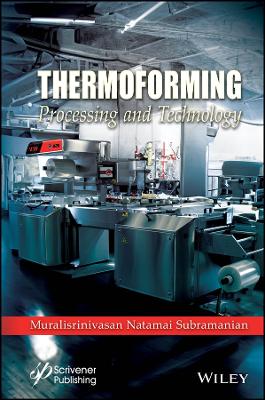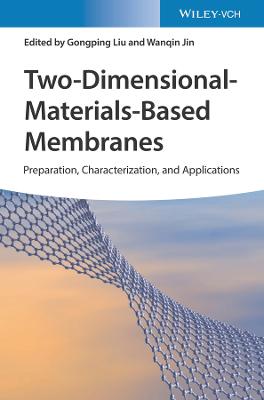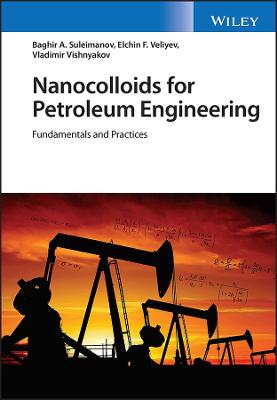Thermoforming
 -10%
portes grátis
-10%
portes grátis
Thermoforming
Processing and Technology
Subramanian, Muralisrinivasan Natamai
John Wiley & Sons Inc
07/2024
352
Dura
Inglês
9781119555865
15 a 20 dias
666
Descrição não disponível.
Preface xiii
1 Introduction 1
2 Polymers 5
2.1 Introduction 5
2.2 Physics and Chemistry of Polymers 6
2.3 Natural Polymers 6
2.4 Synthetic Polymers 7
2.5 Polymerization Methods 8
2.5.1 Addition Polymerization 8
2.5.2 Condensation Polymerization 9
2.6 Polymer Molecules in Thermoforming 10
2.7 Classification 11
2.8 Primary Classification 11
2.8.1 Homopolymers 11
2.8.2 Copolymers 12
2.8.2.1 Block Copolymers 13
2.8.2.2 Diblock Copolymers 16
2.8.2.3 Multiblock Copolymers 16
2.8.3 Alternating Copolymers 17
2.8.4 Random Copolymers 18
2.8.5 Graft Copolymers 18
2.8.6 Impact Copolymers 19
2.9 Secondary Classification 20
2.9.1 Thermoplastics 20
2.9.2 Thermosetting Plastics 22
2.10 Distinction Between Thermoplastics and Thermosetting 22
2.11 General Classification 23
2.11.1 Commodity Plastics 23
2.11.2 Engineering Plastics 24
3 Thermoplastics 27
3.1 Introduction 27
3.2 Polyolefins 27
3.3 Polyethylene 28
3.3.1 Low Density Polyethylene (LDPE) 29
3.3.2 High-Density Polyethylene (HDPE) 30
3.3.3 Linear-Low-Density Polyethylene (LLDPE) 32
3.4 Polypropylene 33
3.5 Polystyrene (PS) 37
3.6 High-Impact Polystyrene (HIPS) 39
3.7 Polyvinylchloride 40
3.8 Acrylonitrile-Butadiene-Styrene (ABS) 41
3.9 Polyethylene Terephthalate (PET) 44
3.10 Acrylics 45
3.10.1 Polymethylmethacrylate (PMMA) 46
3.11 Nylon 6 (PA6) 48
3.12 Nylon 66 (PA66) 49
3.13 Polyoxymethylene (POM) 50
3.14 Polycarbonate (PC) 51
3.15 Poly(ether-ether-ketone) (PEEK) 53
3.16 Polyphenylene Oxide (PPO) 54
3.17 Polybutylene Terephthalate (PBT) 55
3.18 Liquid Crystalline Polymers 57
3.19 Cyclic Olefin Copolymer (COC) 57
3.20 Plastic Foams 58
3.21 Thermoplastic Elastomers 60
3.21.1 Thermoplastic Olefin (TPO) 60
3.21.2 Thermoplastic Urethane (TPU) 61
3.22 Thermoplastic Composites (TCs) 62
3.23 Bioplastics 65
3.23.1 Polylactic Acid (PLA) 65
3.23.2 Poly(Butylene Succinate) (PBS) 67
4 Properties of Thermoplastic Sheet Materials 69
4.1 Introduction 69
4.2 Polymer Characteristics 69
4.3 Polymer Morphology 70
4.3.1 Amorphous Polymers 71
4.3.2 Semi-Crystalline Polymers 72
4.3.3 Crystalline Polymers 74
4.3.4 Amorphous Versus Semi-Crystalline Polymers 75
4.4 Molecular Structure 76
4.5 Molecular Weight 77
4.6 Molecular Weight Distribution 77
4.7 Melt Flow Index 78
4.8 Glass Transition Temperature 79
4.9 Melt Temperature 82
4.10 Heat Deflection Temperature (HDT) 83
4.11 Crystallization Temperature 84
4.12 Melt Strength 86
4.13 Rheological Properties 89
4.14 Viscoelastic Behavior 89
4.15 Coefficient of Friction 92
4.16 Thermal Conductivity 93
4.17 Thermal Diffusivity 94
4.18 Specific Heat 95
4.19 Stress 96
4.20 Strain Hardening 97
4.21 Plastic Strain 99
4.22 Tensile Strain 100
4.23 Tensile Yield Stress 101
4.24 Deformation 102
4.25 Stress Deformation 104
4.26 Modulus and Stiffness 106
4.27 Sag 107
4.28 Toughness 107
4.29 Effect of Additives 108
5 Thermoforming Technology 111
5.1 Introduction 111
5.2 Thermoplastic Sheet Materials 111
5.3 Mechanical Characteristics 112
5.4 Thermoformability 113
5.5 Thermoforming Cycle 114
5.6 Draw Ratio 115
5.7 Processing Window 116
5.8 Mold 118
5.9 Mold Design 119
5.10 Heating Elements 123
5.10.1 Infrared Heaters 124
5.10.2 Flash Heaters 125
5.10.3 Forced Convection Hot Air Heating 125
5.10.4 Other Heaters 126
5.11 Plug Material 127
5.12 Plug Design 128
5.13 Product Design 129
5.14 Clamping 131
5.15 Process Control 132
5.16 Process Variables 133
5.17 Thermal History 138
5.18 Pre-Drying 140
5.19 Plug Movement 140
5.20 Plug Speed 141
5.21 Sheet Temperature 141
5.22 Mold Temperature 143
5.23 Forming Temperature 144
5.24 Wall Thickness Distribution 144
5.25 Sheet Deformation 145
5.26 Heat Transfer 146
5.27 Effects of Temperature Distribution 147
5.28 Effect of Drawing 147
5.29 Effect of Frictional Force 148
5.30 Effect of Plug-Assist/Vacuum 148
5.31 Effect of Applied Pressure 149
5.32 Effect of Heating 150
5.33 Effect of Cooling 151
5.34 Rate of Deforming 153
5.35 Rate of Sagging 154
5.36 Effect of Air Temperature 155
5.37 Effect of Air Pressure 155
5.38 Effect of Crystallinity and Morphology 157
5.39 Processing Technology 158
5.39.1 Heating Stage 159
5.39.2 Sheet Heating 159
5.39.3 Forming Stage 160
5.39.4 Draw Ratio 160
5.39.5 Cooling Stage 160
5.40 Thermoforming-Processing of Thermoplastic Sheet Material 161
5.41 Methods of Thermoforming 163
5.42 Low-Pressure Forming Technology 163
5.42.1 Basic Vacuum Forming 163
5.43 Plug-Assist Thermoforming 165
5.43.1 Plug-Assist Vacuum Forming 166
5.44 Pressure Forming 167
5.44.1 Plug Assist-Air Pressure Thermoforming 169
5.45 Snapback Thermoforming 170
5.46 Drape Forming 171
5.47 Matched Mold Forming 172
5.48 Foam Sheet Forming 173
5.49 In-Line Thermoforming 174
5.50 Industrial Versus Laboratory Thermoforming 176
6 Troubleshooting Thermoforming 179
6.1 Introduction 179
6.2 Product Quality Analysis 180
6.3 Product Quality 181
6.4 Product Defects 181
6.5 Fundamental and Inherent Defects 183
6.6 Troubleshooting 186
6.6.1 Blisters or Bubbles 186
6.6.2 Webbing/Bridging 188
6.6.3 Excessive Sheet Sag 189
6.6.4 Pinhole or Rupturing 190
6.6.5 Uneven Sag 191
6.6.6 Part Sticks to the Mold 192
6.6.7 Stretch Marks 193
6.6.8 Nipple on the Mold Side of the Thermoformed Part 193
6.6.9 Pock Marks 194
6.6.10 Poor Wall Thickness 195
6.6.11 Uneven Edges 196
6.6.12 Tearing Sheet When Forming 197
6.6.13 Bad Definition at the Edge 198
6.6.14 Glossy Spots 199
6.6.15 Warpage 200
6.6.16 Cracking in Corners 201
6.6.17 Raised Corners 202
6.6.18 Surface Marking 202
6.6.19 Corners Too Thin 204
6.6.20 Folds, Webbing, or Wrinkles 204
6.6.21 Part Deforms During Demolding 205
6.6.22 Poor Part Detail 206
6.6.23 Excessive Post Shrinkage 207
7 Thermoforming-Optimization 209
7.1 Introduction 209
7.2 Thermoforming 209
7.3 Optimization Process 210
7.4 Numerical Modeling 211
7.5 Constitutive Model 212
7.6 Key Findings-Modeling 214
7.6.1 Selection of Material 214
7.6.2 Wall Thickness 215
7.7 Mold 215
7.8 Thermoforming Process 216
7.9 Viscoelastic Behavior 216
7.10 Method of Thermoforming 216
7.11 Heating 216
7.12 Cooling 217
7.13 Computer Simulation 217
7.14 Polyflow 218
7.15 PAM-FORM (TM) Software 219
7.16 Geometric Element Analysis (GEA) 219
8 Case Studies 221
8.1 Introduction 221
8.2 Case Studies-Brief Details 222
8.3 Case Study I 222
8.3.1 Challenge 223
8.3.2 Problem Statement 224
8.3.3 In-Depth Analysis 224
8.3.4 Quantitative and Qualitative Data 225
8.3.5 Findings 225
8.3.6 Immersive Chronicle 226
8.4 Case Study II 227
8.4.1 Issue 229
8.4.2 Problem Statement 229
8.4.3 In-Depth Analysis 229
8.4.4 Analysis of Quantitative and Qualitative Data 231
8.4.5 Customer Satisfaction and Appreciation 232
8.4.6 Findings 232
8.4.7 Captivating Account 233
8.5 The Significance of Case Studies in Thermoforming 235
9 Applications 237
9.1 Introduction 237
9.2 World of Thermoformed Products 237
9.2.1 Packaging 238
9.2.2 Agriculture 238
9.2.3 Appliances and Consumer Goods 239
9.2.4 Analytical and Laboratory Equipment 241
9.2.5 Automotive and Aerospace Industry 241
9.2.6 Blister Packaging 244
9.2.7 Building/Construction Products 244
9.2.8 Electrical and Electronics 245
9.2.9 Health-Care Packaging 247
9.2.10 Medical Applications 248
9.2.11 Packaging 250
9.2.12 Semiconductor Industry 252
9.2.13 Signs/Displays 252
9.2.14 Sports and Recreation 253
9.2.15 Transportation 255
9.2.16 Waste Management 255
9.2.17 Water Filtration Systems 255
9.2.18 Industrial Applications 255
9.2.19 Marine and Watercraft Industry 257
9.3 Market Trends 257
9.3.1 Current Market 257
9.3.2 Future Market 258
10 Conclusion 261
References 265
Index 313
1 Introduction 1
2 Polymers 5
2.1 Introduction 5
2.2 Physics and Chemistry of Polymers 6
2.3 Natural Polymers 6
2.4 Synthetic Polymers 7
2.5 Polymerization Methods 8
2.5.1 Addition Polymerization 8
2.5.2 Condensation Polymerization 9
2.6 Polymer Molecules in Thermoforming 10
2.7 Classification 11
2.8 Primary Classification 11
2.8.1 Homopolymers 11
2.8.2 Copolymers 12
2.8.2.1 Block Copolymers 13
2.8.2.2 Diblock Copolymers 16
2.8.2.3 Multiblock Copolymers 16
2.8.3 Alternating Copolymers 17
2.8.4 Random Copolymers 18
2.8.5 Graft Copolymers 18
2.8.6 Impact Copolymers 19
2.9 Secondary Classification 20
2.9.1 Thermoplastics 20
2.9.2 Thermosetting Plastics 22
2.10 Distinction Between Thermoplastics and Thermosetting 22
2.11 General Classification 23
2.11.1 Commodity Plastics 23
2.11.2 Engineering Plastics 24
3 Thermoplastics 27
3.1 Introduction 27
3.2 Polyolefins 27
3.3 Polyethylene 28
3.3.1 Low Density Polyethylene (LDPE) 29
3.3.2 High-Density Polyethylene (HDPE) 30
3.3.3 Linear-Low-Density Polyethylene (LLDPE) 32
3.4 Polypropylene 33
3.5 Polystyrene (PS) 37
3.6 High-Impact Polystyrene (HIPS) 39
3.7 Polyvinylchloride 40
3.8 Acrylonitrile-Butadiene-Styrene (ABS) 41
3.9 Polyethylene Terephthalate (PET) 44
3.10 Acrylics 45
3.10.1 Polymethylmethacrylate (PMMA) 46
3.11 Nylon 6 (PA6) 48
3.12 Nylon 66 (PA66) 49
3.13 Polyoxymethylene (POM) 50
3.14 Polycarbonate (PC) 51
3.15 Poly(ether-ether-ketone) (PEEK) 53
3.16 Polyphenylene Oxide (PPO) 54
3.17 Polybutylene Terephthalate (PBT) 55
3.18 Liquid Crystalline Polymers 57
3.19 Cyclic Olefin Copolymer (COC) 57
3.20 Plastic Foams 58
3.21 Thermoplastic Elastomers 60
3.21.1 Thermoplastic Olefin (TPO) 60
3.21.2 Thermoplastic Urethane (TPU) 61
3.22 Thermoplastic Composites (TCs) 62
3.23 Bioplastics 65
3.23.1 Polylactic Acid (PLA) 65
3.23.2 Poly(Butylene Succinate) (PBS) 67
4 Properties of Thermoplastic Sheet Materials 69
4.1 Introduction 69
4.2 Polymer Characteristics 69
4.3 Polymer Morphology 70
4.3.1 Amorphous Polymers 71
4.3.2 Semi-Crystalline Polymers 72
4.3.3 Crystalline Polymers 74
4.3.4 Amorphous Versus Semi-Crystalline Polymers 75
4.4 Molecular Structure 76
4.5 Molecular Weight 77
4.6 Molecular Weight Distribution 77
4.7 Melt Flow Index 78
4.8 Glass Transition Temperature 79
4.9 Melt Temperature 82
4.10 Heat Deflection Temperature (HDT) 83
4.11 Crystallization Temperature 84
4.12 Melt Strength 86
4.13 Rheological Properties 89
4.14 Viscoelastic Behavior 89
4.15 Coefficient of Friction 92
4.16 Thermal Conductivity 93
4.17 Thermal Diffusivity 94
4.18 Specific Heat 95
4.19 Stress 96
4.20 Strain Hardening 97
4.21 Plastic Strain 99
4.22 Tensile Strain 100
4.23 Tensile Yield Stress 101
4.24 Deformation 102
4.25 Stress Deformation 104
4.26 Modulus and Stiffness 106
4.27 Sag 107
4.28 Toughness 107
4.29 Effect of Additives 108
5 Thermoforming Technology 111
5.1 Introduction 111
5.2 Thermoplastic Sheet Materials 111
5.3 Mechanical Characteristics 112
5.4 Thermoformability 113
5.5 Thermoforming Cycle 114
5.6 Draw Ratio 115
5.7 Processing Window 116
5.8 Mold 118
5.9 Mold Design 119
5.10 Heating Elements 123
5.10.1 Infrared Heaters 124
5.10.2 Flash Heaters 125
5.10.3 Forced Convection Hot Air Heating 125
5.10.4 Other Heaters 126
5.11 Plug Material 127
5.12 Plug Design 128
5.13 Product Design 129
5.14 Clamping 131
5.15 Process Control 132
5.16 Process Variables 133
5.17 Thermal History 138
5.18 Pre-Drying 140
5.19 Plug Movement 140
5.20 Plug Speed 141
5.21 Sheet Temperature 141
5.22 Mold Temperature 143
5.23 Forming Temperature 144
5.24 Wall Thickness Distribution 144
5.25 Sheet Deformation 145
5.26 Heat Transfer 146
5.27 Effects of Temperature Distribution 147
5.28 Effect of Drawing 147
5.29 Effect of Frictional Force 148
5.30 Effect of Plug-Assist/Vacuum 148
5.31 Effect of Applied Pressure 149
5.32 Effect of Heating 150
5.33 Effect of Cooling 151
5.34 Rate of Deforming 153
5.35 Rate of Sagging 154
5.36 Effect of Air Temperature 155
5.37 Effect of Air Pressure 155
5.38 Effect of Crystallinity and Morphology 157
5.39 Processing Technology 158
5.39.1 Heating Stage 159
5.39.2 Sheet Heating 159
5.39.3 Forming Stage 160
5.39.4 Draw Ratio 160
5.39.5 Cooling Stage 160
5.40 Thermoforming-Processing of Thermoplastic Sheet Material 161
5.41 Methods of Thermoforming 163
5.42 Low-Pressure Forming Technology 163
5.42.1 Basic Vacuum Forming 163
5.43 Plug-Assist Thermoforming 165
5.43.1 Plug-Assist Vacuum Forming 166
5.44 Pressure Forming 167
5.44.1 Plug Assist-Air Pressure Thermoforming 169
5.45 Snapback Thermoforming 170
5.46 Drape Forming 171
5.47 Matched Mold Forming 172
5.48 Foam Sheet Forming 173
5.49 In-Line Thermoforming 174
5.50 Industrial Versus Laboratory Thermoforming 176
6 Troubleshooting Thermoforming 179
6.1 Introduction 179
6.2 Product Quality Analysis 180
6.3 Product Quality 181
6.4 Product Defects 181
6.5 Fundamental and Inherent Defects 183
6.6 Troubleshooting 186
6.6.1 Blisters or Bubbles 186
6.6.2 Webbing/Bridging 188
6.6.3 Excessive Sheet Sag 189
6.6.4 Pinhole or Rupturing 190
6.6.5 Uneven Sag 191
6.6.6 Part Sticks to the Mold 192
6.6.7 Stretch Marks 193
6.6.8 Nipple on the Mold Side of the Thermoformed Part 193
6.6.9 Pock Marks 194
6.6.10 Poor Wall Thickness 195
6.6.11 Uneven Edges 196
6.6.12 Tearing Sheet When Forming 197
6.6.13 Bad Definition at the Edge 198
6.6.14 Glossy Spots 199
6.6.15 Warpage 200
6.6.16 Cracking in Corners 201
6.6.17 Raised Corners 202
6.6.18 Surface Marking 202
6.6.19 Corners Too Thin 204
6.6.20 Folds, Webbing, or Wrinkles 204
6.6.21 Part Deforms During Demolding 205
6.6.22 Poor Part Detail 206
6.6.23 Excessive Post Shrinkage 207
7 Thermoforming-Optimization 209
7.1 Introduction 209
7.2 Thermoforming 209
7.3 Optimization Process 210
7.4 Numerical Modeling 211
7.5 Constitutive Model 212
7.6 Key Findings-Modeling 214
7.6.1 Selection of Material 214
7.6.2 Wall Thickness 215
7.7 Mold 215
7.8 Thermoforming Process 216
7.9 Viscoelastic Behavior 216
7.10 Method of Thermoforming 216
7.11 Heating 216
7.12 Cooling 217
7.13 Computer Simulation 217
7.14 Polyflow 218
7.15 PAM-FORM (TM) Software 219
7.16 Geometric Element Analysis (GEA) 219
8 Case Studies 221
8.1 Introduction 221
8.2 Case Studies-Brief Details 222
8.3 Case Study I 222
8.3.1 Challenge 223
8.3.2 Problem Statement 224
8.3.3 In-Depth Analysis 224
8.3.4 Quantitative and Qualitative Data 225
8.3.5 Findings 225
8.3.6 Immersive Chronicle 226
8.4 Case Study II 227
8.4.1 Issue 229
8.4.2 Problem Statement 229
8.4.3 In-Depth Analysis 229
8.4.4 Analysis of Quantitative and Qualitative Data 231
8.4.5 Customer Satisfaction and Appreciation 232
8.4.6 Findings 232
8.4.7 Captivating Account 233
8.5 The Significance of Case Studies in Thermoforming 235
9 Applications 237
9.1 Introduction 237
9.2 World of Thermoformed Products 237
9.2.1 Packaging 238
9.2.2 Agriculture 238
9.2.3 Appliances and Consumer Goods 239
9.2.4 Analytical and Laboratory Equipment 241
9.2.5 Automotive and Aerospace Industry 241
9.2.6 Blister Packaging 244
9.2.7 Building/Construction Products 244
9.2.8 Electrical and Electronics 245
9.2.9 Health-Care Packaging 247
9.2.10 Medical Applications 248
9.2.11 Packaging 250
9.2.12 Semiconductor Industry 252
9.2.13 Signs/Displays 252
9.2.14 Sports and Recreation 253
9.2.15 Transportation 255
9.2.16 Waste Management 255
9.2.17 Water Filtration Systems 255
9.2.18 Industrial Applications 255
9.2.19 Marine and Watercraft Industry 257
9.3 Market Trends 257
9.3.1 Current Market 257
9.3.2 Future Market 258
10 Conclusion 261
References 265
Index 313
Este título pertence ao(s) assunto(s) indicados(s). Para ver outros títulos clique no assunto desejado.
Thermoforming; Plastic Forming; Heating Molding; Vacuum Forming; Pressure Forming; Thermoplastic Materials; Mold Design; Heating Elements; Cooling Systems; Thermoforming Process; Process Optimization; Material Selection; Drape Forming; Sheet Temperatures; Thermoforming Defects
Preface xiii
1 Introduction 1
2 Polymers 5
2.1 Introduction 5
2.2 Physics and Chemistry of Polymers 6
2.3 Natural Polymers 6
2.4 Synthetic Polymers 7
2.5 Polymerization Methods 8
2.5.1 Addition Polymerization 8
2.5.2 Condensation Polymerization 9
2.6 Polymer Molecules in Thermoforming 10
2.7 Classification 11
2.8 Primary Classification 11
2.8.1 Homopolymers 11
2.8.2 Copolymers 12
2.8.2.1 Block Copolymers 13
2.8.2.2 Diblock Copolymers 16
2.8.2.3 Multiblock Copolymers 16
2.8.3 Alternating Copolymers 17
2.8.4 Random Copolymers 18
2.8.5 Graft Copolymers 18
2.8.6 Impact Copolymers 19
2.9 Secondary Classification 20
2.9.1 Thermoplastics 20
2.9.2 Thermosetting Plastics 22
2.10 Distinction Between Thermoplastics and Thermosetting 22
2.11 General Classification 23
2.11.1 Commodity Plastics 23
2.11.2 Engineering Plastics 24
3 Thermoplastics 27
3.1 Introduction 27
3.2 Polyolefins 27
3.3 Polyethylene 28
3.3.1 Low Density Polyethylene (LDPE) 29
3.3.2 High-Density Polyethylene (HDPE) 30
3.3.3 Linear-Low-Density Polyethylene (LLDPE) 32
3.4 Polypropylene 33
3.5 Polystyrene (PS) 37
3.6 High-Impact Polystyrene (HIPS) 39
3.7 Polyvinylchloride 40
3.8 Acrylonitrile-Butadiene-Styrene (ABS) 41
3.9 Polyethylene Terephthalate (PET) 44
3.10 Acrylics 45
3.10.1 Polymethylmethacrylate (PMMA) 46
3.11 Nylon 6 (PA6) 48
3.12 Nylon 66 (PA66) 49
3.13 Polyoxymethylene (POM) 50
3.14 Polycarbonate (PC) 51
3.15 Poly(ether-ether-ketone) (PEEK) 53
3.16 Polyphenylene Oxide (PPO) 54
3.17 Polybutylene Terephthalate (PBT) 55
3.18 Liquid Crystalline Polymers 57
3.19 Cyclic Olefin Copolymer (COC) 57
3.20 Plastic Foams 58
3.21 Thermoplastic Elastomers 60
3.21.1 Thermoplastic Olefin (TPO) 60
3.21.2 Thermoplastic Urethane (TPU) 61
3.22 Thermoplastic Composites (TCs) 62
3.23 Bioplastics 65
3.23.1 Polylactic Acid (PLA) 65
3.23.2 Poly(Butylene Succinate) (PBS) 67
4 Properties of Thermoplastic Sheet Materials 69
4.1 Introduction 69
4.2 Polymer Characteristics 69
4.3 Polymer Morphology 70
4.3.1 Amorphous Polymers 71
4.3.2 Semi-Crystalline Polymers 72
4.3.3 Crystalline Polymers 74
4.3.4 Amorphous Versus Semi-Crystalline Polymers 75
4.4 Molecular Structure 76
4.5 Molecular Weight 77
4.6 Molecular Weight Distribution 77
4.7 Melt Flow Index 78
4.8 Glass Transition Temperature 79
4.9 Melt Temperature 82
4.10 Heat Deflection Temperature (HDT) 83
4.11 Crystallization Temperature 84
4.12 Melt Strength 86
4.13 Rheological Properties 89
4.14 Viscoelastic Behavior 89
4.15 Coefficient of Friction 92
4.16 Thermal Conductivity 93
4.17 Thermal Diffusivity 94
4.18 Specific Heat 95
4.19 Stress 96
4.20 Strain Hardening 97
4.21 Plastic Strain 99
4.22 Tensile Strain 100
4.23 Tensile Yield Stress 101
4.24 Deformation 102
4.25 Stress Deformation 104
4.26 Modulus and Stiffness 106
4.27 Sag 107
4.28 Toughness 107
4.29 Effect of Additives 108
5 Thermoforming Technology 111
5.1 Introduction 111
5.2 Thermoplastic Sheet Materials 111
5.3 Mechanical Characteristics 112
5.4 Thermoformability 113
5.5 Thermoforming Cycle 114
5.6 Draw Ratio 115
5.7 Processing Window 116
5.8 Mold 118
5.9 Mold Design 119
5.10 Heating Elements 123
5.10.1 Infrared Heaters 124
5.10.2 Flash Heaters 125
5.10.3 Forced Convection Hot Air Heating 125
5.10.4 Other Heaters 126
5.11 Plug Material 127
5.12 Plug Design 128
5.13 Product Design 129
5.14 Clamping 131
5.15 Process Control 132
5.16 Process Variables 133
5.17 Thermal History 138
5.18 Pre-Drying 140
5.19 Plug Movement 140
5.20 Plug Speed 141
5.21 Sheet Temperature 141
5.22 Mold Temperature 143
5.23 Forming Temperature 144
5.24 Wall Thickness Distribution 144
5.25 Sheet Deformation 145
5.26 Heat Transfer 146
5.27 Effects of Temperature Distribution 147
5.28 Effect of Drawing 147
5.29 Effect of Frictional Force 148
5.30 Effect of Plug-Assist/Vacuum 148
5.31 Effect of Applied Pressure 149
5.32 Effect of Heating 150
5.33 Effect of Cooling 151
5.34 Rate of Deforming 153
5.35 Rate of Sagging 154
5.36 Effect of Air Temperature 155
5.37 Effect of Air Pressure 155
5.38 Effect of Crystallinity and Morphology 157
5.39 Processing Technology 158
5.39.1 Heating Stage 159
5.39.2 Sheet Heating 159
5.39.3 Forming Stage 160
5.39.4 Draw Ratio 160
5.39.5 Cooling Stage 160
5.40 Thermoforming-Processing of Thermoplastic Sheet Material 161
5.41 Methods of Thermoforming 163
5.42 Low-Pressure Forming Technology 163
5.42.1 Basic Vacuum Forming 163
5.43 Plug-Assist Thermoforming 165
5.43.1 Plug-Assist Vacuum Forming 166
5.44 Pressure Forming 167
5.44.1 Plug Assist-Air Pressure Thermoforming 169
5.45 Snapback Thermoforming 170
5.46 Drape Forming 171
5.47 Matched Mold Forming 172
5.48 Foam Sheet Forming 173
5.49 In-Line Thermoforming 174
5.50 Industrial Versus Laboratory Thermoforming 176
6 Troubleshooting Thermoforming 179
6.1 Introduction 179
6.2 Product Quality Analysis 180
6.3 Product Quality 181
6.4 Product Defects 181
6.5 Fundamental and Inherent Defects 183
6.6 Troubleshooting 186
6.6.1 Blisters or Bubbles 186
6.6.2 Webbing/Bridging 188
6.6.3 Excessive Sheet Sag 189
6.6.4 Pinhole or Rupturing 190
6.6.5 Uneven Sag 191
6.6.6 Part Sticks to the Mold 192
6.6.7 Stretch Marks 193
6.6.8 Nipple on the Mold Side of the Thermoformed Part 193
6.6.9 Pock Marks 194
6.6.10 Poor Wall Thickness 195
6.6.11 Uneven Edges 196
6.6.12 Tearing Sheet When Forming 197
6.6.13 Bad Definition at the Edge 198
6.6.14 Glossy Spots 199
6.6.15 Warpage 200
6.6.16 Cracking in Corners 201
6.6.17 Raised Corners 202
6.6.18 Surface Marking 202
6.6.19 Corners Too Thin 204
6.6.20 Folds, Webbing, or Wrinkles 204
6.6.21 Part Deforms During Demolding 205
6.6.22 Poor Part Detail 206
6.6.23 Excessive Post Shrinkage 207
7 Thermoforming-Optimization 209
7.1 Introduction 209
7.2 Thermoforming 209
7.3 Optimization Process 210
7.4 Numerical Modeling 211
7.5 Constitutive Model 212
7.6 Key Findings-Modeling 214
7.6.1 Selection of Material 214
7.6.2 Wall Thickness 215
7.7 Mold 215
7.8 Thermoforming Process 216
7.9 Viscoelastic Behavior 216
7.10 Method of Thermoforming 216
7.11 Heating 216
7.12 Cooling 217
7.13 Computer Simulation 217
7.14 Polyflow 218
7.15 PAM-FORM (TM) Software 219
7.16 Geometric Element Analysis (GEA) 219
8 Case Studies 221
8.1 Introduction 221
8.2 Case Studies-Brief Details 222
8.3 Case Study I 222
8.3.1 Challenge 223
8.3.2 Problem Statement 224
8.3.3 In-Depth Analysis 224
8.3.4 Quantitative and Qualitative Data 225
8.3.5 Findings 225
8.3.6 Immersive Chronicle 226
8.4 Case Study II 227
8.4.1 Issue 229
8.4.2 Problem Statement 229
8.4.3 In-Depth Analysis 229
8.4.4 Analysis of Quantitative and Qualitative Data 231
8.4.5 Customer Satisfaction and Appreciation 232
8.4.6 Findings 232
8.4.7 Captivating Account 233
8.5 The Significance of Case Studies in Thermoforming 235
9 Applications 237
9.1 Introduction 237
9.2 World of Thermoformed Products 237
9.2.1 Packaging 238
9.2.2 Agriculture 238
9.2.3 Appliances and Consumer Goods 239
9.2.4 Analytical and Laboratory Equipment 241
9.2.5 Automotive and Aerospace Industry 241
9.2.6 Blister Packaging 244
9.2.7 Building/Construction Products 244
9.2.8 Electrical and Electronics 245
9.2.9 Health-Care Packaging 247
9.2.10 Medical Applications 248
9.2.11 Packaging 250
9.2.12 Semiconductor Industry 252
9.2.13 Signs/Displays 252
9.2.14 Sports and Recreation 253
9.2.15 Transportation 255
9.2.16 Waste Management 255
9.2.17 Water Filtration Systems 255
9.2.18 Industrial Applications 255
9.2.19 Marine and Watercraft Industry 257
9.3 Market Trends 257
9.3.1 Current Market 257
9.3.2 Future Market 258
10 Conclusion 261
References 265
Index 313
1 Introduction 1
2 Polymers 5
2.1 Introduction 5
2.2 Physics and Chemistry of Polymers 6
2.3 Natural Polymers 6
2.4 Synthetic Polymers 7
2.5 Polymerization Methods 8
2.5.1 Addition Polymerization 8
2.5.2 Condensation Polymerization 9
2.6 Polymer Molecules in Thermoforming 10
2.7 Classification 11
2.8 Primary Classification 11
2.8.1 Homopolymers 11
2.8.2 Copolymers 12
2.8.2.1 Block Copolymers 13
2.8.2.2 Diblock Copolymers 16
2.8.2.3 Multiblock Copolymers 16
2.8.3 Alternating Copolymers 17
2.8.4 Random Copolymers 18
2.8.5 Graft Copolymers 18
2.8.6 Impact Copolymers 19
2.9 Secondary Classification 20
2.9.1 Thermoplastics 20
2.9.2 Thermosetting Plastics 22
2.10 Distinction Between Thermoplastics and Thermosetting 22
2.11 General Classification 23
2.11.1 Commodity Plastics 23
2.11.2 Engineering Plastics 24
3 Thermoplastics 27
3.1 Introduction 27
3.2 Polyolefins 27
3.3 Polyethylene 28
3.3.1 Low Density Polyethylene (LDPE) 29
3.3.2 High-Density Polyethylene (HDPE) 30
3.3.3 Linear-Low-Density Polyethylene (LLDPE) 32
3.4 Polypropylene 33
3.5 Polystyrene (PS) 37
3.6 High-Impact Polystyrene (HIPS) 39
3.7 Polyvinylchloride 40
3.8 Acrylonitrile-Butadiene-Styrene (ABS) 41
3.9 Polyethylene Terephthalate (PET) 44
3.10 Acrylics 45
3.10.1 Polymethylmethacrylate (PMMA) 46
3.11 Nylon 6 (PA6) 48
3.12 Nylon 66 (PA66) 49
3.13 Polyoxymethylene (POM) 50
3.14 Polycarbonate (PC) 51
3.15 Poly(ether-ether-ketone) (PEEK) 53
3.16 Polyphenylene Oxide (PPO) 54
3.17 Polybutylene Terephthalate (PBT) 55
3.18 Liquid Crystalline Polymers 57
3.19 Cyclic Olefin Copolymer (COC) 57
3.20 Plastic Foams 58
3.21 Thermoplastic Elastomers 60
3.21.1 Thermoplastic Olefin (TPO) 60
3.21.2 Thermoplastic Urethane (TPU) 61
3.22 Thermoplastic Composites (TCs) 62
3.23 Bioplastics 65
3.23.1 Polylactic Acid (PLA) 65
3.23.2 Poly(Butylene Succinate) (PBS) 67
4 Properties of Thermoplastic Sheet Materials 69
4.1 Introduction 69
4.2 Polymer Characteristics 69
4.3 Polymer Morphology 70
4.3.1 Amorphous Polymers 71
4.3.2 Semi-Crystalline Polymers 72
4.3.3 Crystalline Polymers 74
4.3.4 Amorphous Versus Semi-Crystalline Polymers 75
4.4 Molecular Structure 76
4.5 Molecular Weight 77
4.6 Molecular Weight Distribution 77
4.7 Melt Flow Index 78
4.8 Glass Transition Temperature 79
4.9 Melt Temperature 82
4.10 Heat Deflection Temperature (HDT) 83
4.11 Crystallization Temperature 84
4.12 Melt Strength 86
4.13 Rheological Properties 89
4.14 Viscoelastic Behavior 89
4.15 Coefficient of Friction 92
4.16 Thermal Conductivity 93
4.17 Thermal Diffusivity 94
4.18 Specific Heat 95
4.19 Stress 96
4.20 Strain Hardening 97
4.21 Plastic Strain 99
4.22 Tensile Strain 100
4.23 Tensile Yield Stress 101
4.24 Deformation 102
4.25 Stress Deformation 104
4.26 Modulus and Stiffness 106
4.27 Sag 107
4.28 Toughness 107
4.29 Effect of Additives 108
5 Thermoforming Technology 111
5.1 Introduction 111
5.2 Thermoplastic Sheet Materials 111
5.3 Mechanical Characteristics 112
5.4 Thermoformability 113
5.5 Thermoforming Cycle 114
5.6 Draw Ratio 115
5.7 Processing Window 116
5.8 Mold 118
5.9 Mold Design 119
5.10 Heating Elements 123
5.10.1 Infrared Heaters 124
5.10.2 Flash Heaters 125
5.10.3 Forced Convection Hot Air Heating 125
5.10.4 Other Heaters 126
5.11 Plug Material 127
5.12 Plug Design 128
5.13 Product Design 129
5.14 Clamping 131
5.15 Process Control 132
5.16 Process Variables 133
5.17 Thermal History 138
5.18 Pre-Drying 140
5.19 Plug Movement 140
5.20 Plug Speed 141
5.21 Sheet Temperature 141
5.22 Mold Temperature 143
5.23 Forming Temperature 144
5.24 Wall Thickness Distribution 144
5.25 Sheet Deformation 145
5.26 Heat Transfer 146
5.27 Effects of Temperature Distribution 147
5.28 Effect of Drawing 147
5.29 Effect of Frictional Force 148
5.30 Effect of Plug-Assist/Vacuum 148
5.31 Effect of Applied Pressure 149
5.32 Effect of Heating 150
5.33 Effect of Cooling 151
5.34 Rate of Deforming 153
5.35 Rate of Sagging 154
5.36 Effect of Air Temperature 155
5.37 Effect of Air Pressure 155
5.38 Effect of Crystallinity and Morphology 157
5.39 Processing Technology 158
5.39.1 Heating Stage 159
5.39.2 Sheet Heating 159
5.39.3 Forming Stage 160
5.39.4 Draw Ratio 160
5.39.5 Cooling Stage 160
5.40 Thermoforming-Processing of Thermoplastic Sheet Material 161
5.41 Methods of Thermoforming 163
5.42 Low-Pressure Forming Technology 163
5.42.1 Basic Vacuum Forming 163
5.43 Plug-Assist Thermoforming 165
5.43.1 Plug-Assist Vacuum Forming 166
5.44 Pressure Forming 167
5.44.1 Plug Assist-Air Pressure Thermoforming 169
5.45 Snapback Thermoforming 170
5.46 Drape Forming 171
5.47 Matched Mold Forming 172
5.48 Foam Sheet Forming 173
5.49 In-Line Thermoforming 174
5.50 Industrial Versus Laboratory Thermoforming 176
6 Troubleshooting Thermoforming 179
6.1 Introduction 179
6.2 Product Quality Analysis 180
6.3 Product Quality 181
6.4 Product Defects 181
6.5 Fundamental and Inherent Defects 183
6.6 Troubleshooting 186
6.6.1 Blisters or Bubbles 186
6.6.2 Webbing/Bridging 188
6.6.3 Excessive Sheet Sag 189
6.6.4 Pinhole or Rupturing 190
6.6.5 Uneven Sag 191
6.6.6 Part Sticks to the Mold 192
6.6.7 Stretch Marks 193
6.6.8 Nipple on the Mold Side of the Thermoformed Part 193
6.6.9 Pock Marks 194
6.6.10 Poor Wall Thickness 195
6.6.11 Uneven Edges 196
6.6.12 Tearing Sheet When Forming 197
6.6.13 Bad Definition at the Edge 198
6.6.14 Glossy Spots 199
6.6.15 Warpage 200
6.6.16 Cracking in Corners 201
6.6.17 Raised Corners 202
6.6.18 Surface Marking 202
6.6.19 Corners Too Thin 204
6.6.20 Folds, Webbing, or Wrinkles 204
6.6.21 Part Deforms During Demolding 205
6.6.22 Poor Part Detail 206
6.6.23 Excessive Post Shrinkage 207
7 Thermoforming-Optimization 209
7.1 Introduction 209
7.2 Thermoforming 209
7.3 Optimization Process 210
7.4 Numerical Modeling 211
7.5 Constitutive Model 212
7.6 Key Findings-Modeling 214
7.6.1 Selection of Material 214
7.6.2 Wall Thickness 215
7.7 Mold 215
7.8 Thermoforming Process 216
7.9 Viscoelastic Behavior 216
7.10 Method of Thermoforming 216
7.11 Heating 216
7.12 Cooling 217
7.13 Computer Simulation 217
7.14 Polyflow 218
7.15 PAM-FORM (TM) Software 219
7.16 Geometric Element Analysis (GEA) 219
8 Case Studies 221
8.1 Introduction 221
8.2 Case Studies-Brief Details 222
8.3 Case Study I 222
8.3.1 Challenge 223
8.3.2 Problem Statement 224
8.3.3 In-Depth Analysis 224
8.3.4 Quantitative and Qualitative Data 225
8.3.5 Findings 225
8.3.6 Immersive Chronicle 226
8.4 Case Study II 227
8.4.1 Issue 229
8.4.2 Problem Statement 229
8.4.3 In-Depth Analysis 229
8.4.4 Analysis of Quantitative and Qualitative Data 231
8.4.5 Customer Satisfaction and Appreciation 232
8.4.6 Findings 232
8.4.7 Captivating Account 233
8.5 The Significance of Case Studies in Thermoforming 235
9 Applications 237
9.1 Introduction 237
9.2 World of Thermoformed Products 237
9.2.1 Packaging 238
9.2.2 Agriculture 238
9.2.3 Appliances and Consumer Goods 239
9.2.4 Analytical and Laboratory Equipment 241
9.2.5 Automotive and Aerospace Industry 241
9.2.6 Blister Packaging 244
9.2.7 Building/Construction Products 244
9.2.8 Electrical and Electronics 245
9.2.9 Health-Care Packaging 247
9.2.10 Medical Applications 248
9.2.11 Packaging 250
9.2.12 Semiconductor Industry 252
9.2.13 Signs/Displays 252
9.2.14 Sports and Recreation 253
9.2.15 Transportation 255
9.2.16 Waste Management 255
9.2.17 Water Filtration Systems 255
9.2.18 Industrial Applications 255
9.2.19 Marine and Watercraft Industry 257
9.3 Market Trends 257
9.3.1 Current Market 257
9.3.2 Future Market 258
10 Conclusion 261
References 265
Index 313
Este título pertence ao(s) assunto(s) indicados(s). Para ver outros títulos clique no assunto desejado.







